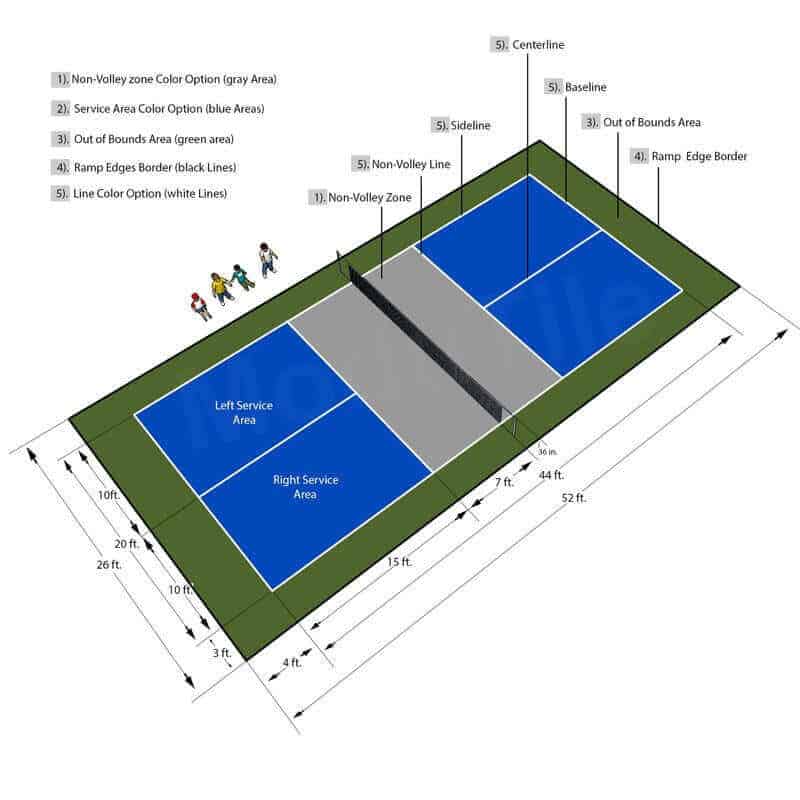Pickleball Court Construction-- Professional Installation for Your Desire Court
Lasting Practices in Pickleball Court Building You Ought To Know
As the appeal of pickleball remains to rise, so too does the requirement for lasting methods in court building and construction. This technique not just addresses environmental issues yet also enhances the durability and functionality of the courts. From choosing environment-friendly materials to applying effective drain and energy-saving illumination services, there are numerous strategies to think about. Yet, the influence of these practices expands much beyond the court itself. Comprehending exactly how each aspect adds to a much more sustainable future invites even more expedition into the elaborate balance between leisure development and ecological stewardship.
Picking Eco-Friendly Materials
Choosing eco-friendly products is an important step in the building and construction of sustainable pickleball courts. The option of lasting materials not just minimizes ecological impact yet also improves the long life and efficiency of the court. Trick materials include recycled rubber for the surface, which uses excellent longevity and shock absorption while diverting waste from landfills.
In addition, using locally sourced materials lowers transportation emissions and supports local economies. Pickleball court construction. For instance, utilizing indigenous woods for fencing and seats can offer a lasting aesthetic while guaranteeing durability against the aspects.
Integrating permeable materials for court foundations can better add to sustainability by enabling all-natural water drain and minimizing overflow. These choices not just secure local communities however also advertise healthier play environments.
Efficient Water Drainage Solutions
While the choice of environmentally friendly products is necessary, executing reliable drainage solutions is similarly crucial for maintaining sustainable pickleball courts. Correct drainage not just protects the court surface from water damages but likewise decreases erosion and runoff, advertising environmental stability.
Efficient drain systems can consist of permeable paving, which enables water to infiltrate the ground instead of pooling externally. This decreases the probability of standing water, which can lead to mold and various other upkeep issues. Additionally, integrating purposefully placed drain networks and swales can route excess water far from the court location, guaranteeing a completely dry having fun surface area and protecting against dirt disintegration.
Making use of indigenous vegetation in the landscape design around the courts can even more improve water drainage by absorbing excess water and minimizing overflow. These plants require less watering and advertise biodiversity, straightening with sustainable methods.
Moreover, it is important to regularly maintain the drainage system to guarantee its long-lasting efficiency. This consists of cleaning debris and monitoring for clogs. By focusing on effective drainage solutions, pickleball court constructors can dramatically add to the sustainability and longevity of the center, eventually profiting both gamers and the environment.
Energy-Efficient Illumination Options
As the demand for pickleball remains to grow, incorporating energy-efficient illumination options right into court design has become you could try this out progressively important for sustainability. Standard lighting systems commonly consume too much energy, adding to greater operational expenses and environmental effect. Therefore, taking on modern, energy-efficient modern technologies is important for both new building and constructions and remodellings.
LED (Light Emitting Diode) illumination stands out as a premier option because of its durability and energy financial savings (Pickleball court construction). Compared to standard lighting, LEDs utilize roughly 75% much less power and can last up to 25 times longer, significantly decreasing maintenance costs. The directional nature of LED lighting reduces light contamination, making sure that lighting is focused on the court instead than surrounding areas.

Lasting Surface Alternatives
Checking out sustainable surface alternatives for pickleball courts has actually obtained grip among builders and gamers alike. The focus on eco-friendly materials not only lines up with the growing ecological understanding however also boosts the performance and resilience of the courts.
This material offers superb shock absorption, decreasing the danger of injuries for gamers while promoting sustainability. These ceramic tiles are simple to replace and set up, and their versatility allows for different court arrangements.
Natural lawn courts are likewise becoming a sustainable option, promoting biodiversity and lowering the warmth island result. They call for routine maintenance and water, which might not line up with all sustainability goals.

Water Conservation Strategies

One more effective strategy includes the installation of rain harvesting systems. These systems store and gather rainwater for usage in maintaining court surfaces and landscape design. This approach not just conserves drinkable water yet likewise lowers dependence on metropolitan sources.
Moreover, utilizing drought-resistant landscaping around the courts is necessary. Native plants need much less Homepage water and are better adjusted to neighborhood climate problems, thus reducing total water consumption. Furthermore, making use of effective watering systems, such as drip watering, ensures that water is delivered directly to plant roots, decreasing evaporation and waste.
Conclusion
Including sustainable techniques in pickleball court building significantly contributes to ecological preservation and source effectiveness. By focusing on these practices, the building and construction of pickleball courts can straighten with wider environmental objectives while promoting long life and performance within areas.
As the popularity of pickleball continues to rise, so as well does the demand for lasting practices in court building.Picking environmentally friendly materials is a critical step in the building of lasting pickleball courts. By focusing on energy-efficient lights options, pickleball court producers can add to a more sustainable future while meeting the requirements of stakeholders and players alike.Incorporating sustainable surface alternatives not just boosts the efficiency of pickleball courts yet additionally leads the means for applying important source reliable water preservation strategies.Integrating lasting methods in pickleball court building considerably contributes to environmental conservation and source effectiveness.